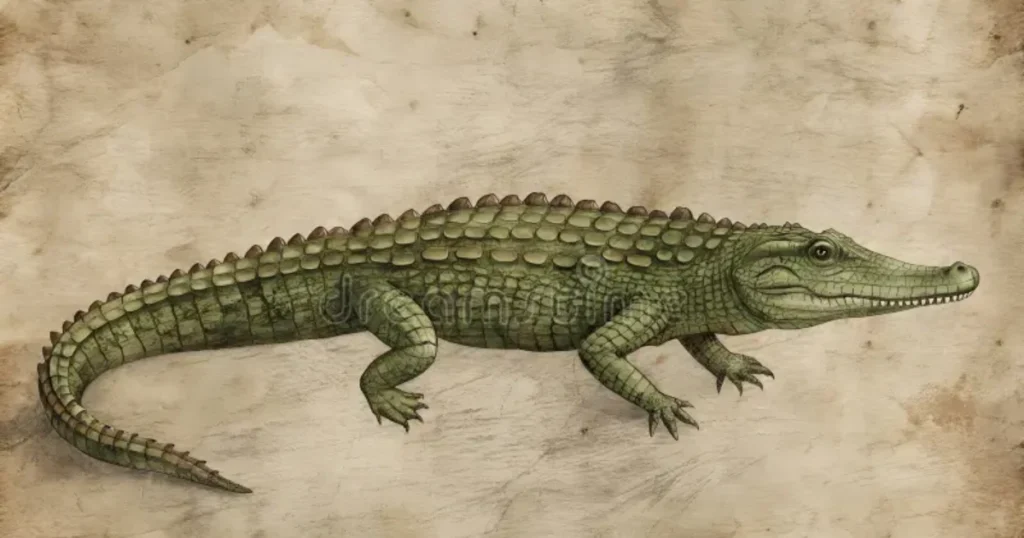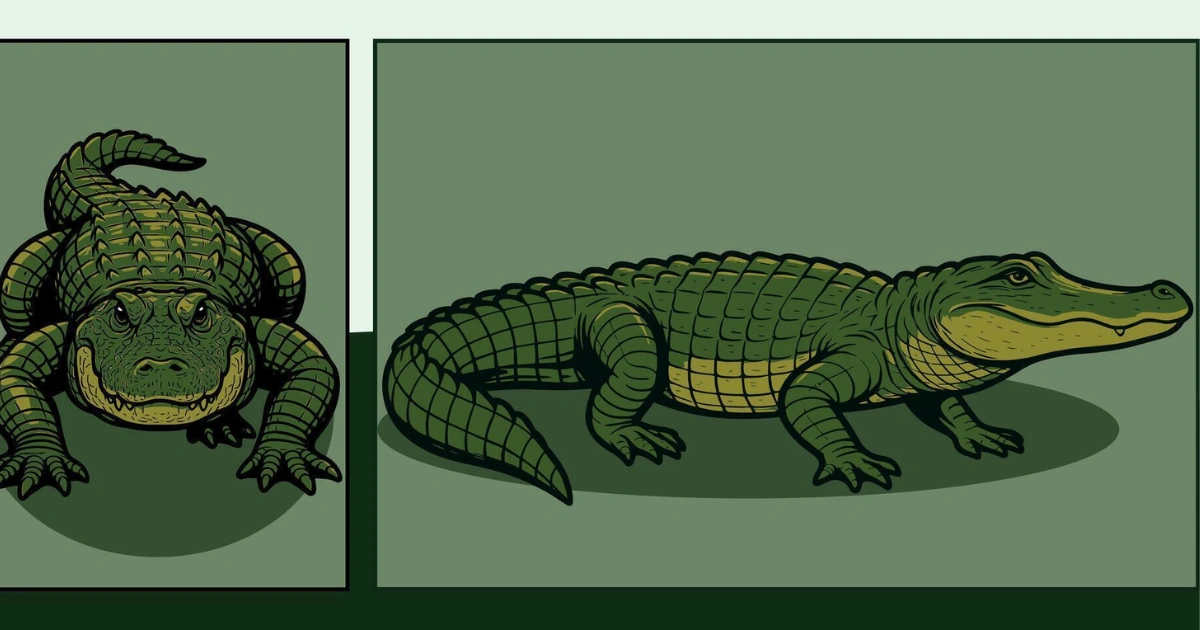Introduction: Why Knowing the Difference Matters
Picture this: you’re walking near a riverbank or through a tropical mangrove, and you spot a massive reptile lounging in the sun. Your heart skips a beat — is it an alligator or a crocodile?
Knowing how to tell these ancient predators apart can help you stay safer, protect these creatures, and deepen your appreciation of their fascinating place in the ecosystem. Despite their similar prehistoric looks, these reptiles differ in key ways you can spot if you know where to look.
In this ultimate guide, you’ll master how to identify them in seconds, understand their habitats, and even learn fun reptile facts to impress your friends. And if you’re interested in exploring more about living alongside wildlife safely, Secrets of the Green Garden has even more tips for respecting nature.
Quick Snapshot: Alligator vs. Crocodile
Before diving deep, here’s a simple cheat sheet:
| Feature | Alligator | Crocodile |
|---|---|---|
| Snout | Broad, U-shaped | Narrow, V-shaped |
| Teeth | Upper teeth mostly visible | Both rows visible |
| Color | Dark grey/black | Olive green/tan |
| Habitat | Freshwater | Salt & freshwater |
| Temperament | Less aggressive | More aggressive |
Memorize this, and you’ll have a quick advantage in the field!
The Famous Tooth Test
Let’s talk smiles — yes, smiles! The easiest way to tell the difference is by looking at their teeth when their mouths are shut.
- Alligator: Their wide upper jaw overlaps the lower, so you usually see only the top row of teeth. Their fourth bottom tooth, which is huge, is hidden behind that broad grin.
- Crocodile: Their upper and lower jaws are about the same width, so their top and bottom teeth interlock — you’ll see a toothy grin even with their mouth closed. The fourth lower tooth is especially prominent, sticking out almost like a fang.
👉 Why does this happen? Over millions of years, crocodiles evolved to display their menacing teeth as a warning, while alligators developed more crushing bite strength with a neater “overbite.”
Snout Shape Differences
One of the easiest field marks is the snout.
✅ Alligators have broad, U-shaped snouts. This wide structure gives them powerful crushing force, perfect for cracking turtle shells and crunchy prey.
✅ Crocodiles have narrower, V-shaped snouts. This slim shape is perfect for catching fish and swift prey in saltwater.
If you see a reptile with a wide, rounded snout — it’s probably an alligator. A pointed, V-like nose? Most likely a crocodile.
Habitat Preferences
Where you find them can also be a huge clue.
🌊 Alligators strongly prefer freshwater habitats like rivers, lakes, and swamps. They rarely venture into saltwater, since they lack specialized glands to get rid of excess salt.
🌊 Crocodiles thrive in both fresh and saltwater thanks to special salt glands on their tongues. You’ll see them in estuaries, mangroves, and even coastal beaches.
In the U.S., for example, Florida is one of the only places you might see both species — but usually, crocs stick closer to brackish water while gators rule the freshwater marshes.

Coloration and Skin Texture
Next up is color.
✅ Alligators: usually darker, deep blackish-grey.
✅ Crocodiles: generally lighter, olive green or tan, helping them blend into sandy, coastal habitats.
Their scaly armor also varies a bit — crocodile skin tends to look more rugged and bumpy, while gators have a smoother, cleaner pattern.
Behavior and Temperament
It’s worth noting:
⚠️ Crocodiles are generally more aggressive and more likely to view humans as prey if provoked or surprised.
⚠️ Alligators tend to be less aggressive, but they will absolutely defend themselves or their nests.
No matter which you see, always keep your distance.
Step-by-Step Field Guide to Identification
If you want to spot the differences like a pro, follow these steps:
- Observe the snout shape carefully — broad means gator, narrow means croc.
- Look at the smile — tucked teeth or exposed teeth?
- Check habitat: freshwater or saltwater?
- Notice the color tone: dark or olive?
- Watch behavior from a safe distance.
- Record the sighting with photos or notes to confirm later.
These small details can make a big difference in correct identification.
Common Mistakes to Avoid
People often get confused — here’s what trips them up:
- Assuming all crocs are bigger. Not always true! Size overlaps.
- Judging only color. Lighting conditions can fool you.
- Thinking all gators live only in swamps. They may wander to ponds or canals, too.
Being thorough in checking multiple traits helps you get it right.
Benefits of Learning These Differences
Why bother learning this stuff?
✅ Safety: know what you’re dealing with
✅ Respect: appreciate these ancient reptiles
✅ Conservation: understanding their role helps protect them
Plus, you can impress friends on your next nature walk with these amazing facts!
Regional & Seasonal Tips
🗓️ Wet season: reptiles are more active, water levels rise, they may move into unexpected areas.
🗓️ Dry season: they may gather at remaining waterholes, making sightings easier — but also riskier for humans.
Wherever you travel, learn about the local reptile species and habits for the season.
Tools & Observation Checklist
Pack smart if you’re wildlife watching:
- 📸 Camera with zoom lens
- 🔭 Binoculars for safe distance viewing
- 🗺️ Regional reptile guidebook
- 🧢 Sun protection
- 🥤 Water bottle
- 🚨 Local emergency contact info saved on your phone
Being prepared makes for safer and more memorable wildlife encounters.
FAQs
Can alligators and crocodiles interbreed?
No — they’re genetically different enough to prevent hybrid offspring.
Which is more dangerous to humans?
Generally crocodiles are more aggressive, but alligators can still be dangerous if approached.
Are crocodiles or alligators endangered?
Some crocodile species are endangered due to habitat loss, while American alligators have recovered thanks to conservation.
How big do they get?
Alligators can reach around 13–15 feet, while some crocodile species surpass 20 feet!
Can you outrun them?
Short answer: yes, if you run away in a straight line — they are fast over a short burst but tire quickly.
Encouraging Conclusion
These incredible reptiles have ruled their waters for millions of years, and with the right knowledge, you can respect and admire them safely. Whether you’re a wildlife lover or a curious adventurer, learning to tell crocodiles from alligators will make your nature experiences richer and more confident.
💬 Share your wildlife stories below, and let others know what you’ve learned! For even more on living alongside nature, visit Secrets of the Green Garden and keep exploring with respect. 🐊🌿


amoxil for sale – amoxil sale amoxil canada
buy fluconazole 100mg for sale – https://gpdifluca.com/# diflucan us
cenforce pills – purchase cenforce without prescription buy cenforce 50mg sale
cheapest 10mg cialis – ciltad genesis cialis and poppers
sanofi cialis otc – cialis purchase canada cialis over the counter in spain
purchase ranitidine without prescription – order ranitidine 300mg zantac 300mg oral
generic viagra sale uk – this buy viagra manchester
The thoroughness in this piece is noteworthy. furosemide pills
More articles like this would frame the blogosphere richer. este sitio
I couldn’t resist commenting. Warmly written! https://ursxdol.com/doxycycline-antibiotic/
The thoroughness in this draft is noteworthy. https://prohnrg.com/product/acyclovir-pills/
Facts blog you have here.. It’s hard to espy high calibre writing like yours these days. I truly comprehend individuals like you! Take vigilance!! effet du kamagra
This is a question which is near to my verve… Numberless thanks! Quite where can I upon the contact details in the course of questions?
https://proisotrepl.com/product/cyclobenzaprine/
I am actually thrilled to gleam at this blog posts which consists of tons of useful facts, thanks object of providing such data. http://www.predictive-datascience.com/forum/member.php?action=profile&uid=44943
order dapagliflozin – https://janozin.com/# buy dapagliflozin medication
xenical price – click where can i buy orlistat
Thanks towards putting this up. It’s understandably done. https://myvisualdatabase.com/forum/profile.php?id=118729
You can conserve yourself and your family by being wary when buying prescription online. Some druggist’s websites manipulate legally and put forward convenience, solitariness, cost savings and safeguards over the extent of purchasing medicines. buy in TerbinaPharmacy https://terbinafines.com/product/aricept.html aricept
You can conserve yourself and your stock close being wary when buying prescription online. Some druggist’s websites manipulate legally and sell convenience, secretiveness, cost savings and safeguards for purchasing medicines. buy in TerbinaPharmacy https://terbinafines.com/product/requip.html requip
Good blog you procure here.. It’s severely to find high status belles-lettres like yours these days. I truly recognize individuals like you! Go through guardianship!! TerbinaPharmacy
You can protect yourself and your family nearby being cautious when buying pharmaceutical online. Some pharmacopoeia websites operate legally and offer convenience, privacy, rate savings and safeguards over the extent of purchasing medicines. http://playbigbassrm.com/
More posts like this would force the blogosphere more useful.
94381 548840My plate is real full and your tryna give me more food, boy what the fuck is wrong wit you?!|guruisthebomb| 611084
https://t.me/s/Drip_officials